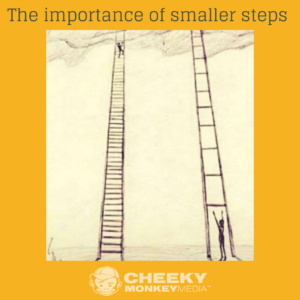So here’s a big question: How can you ensure your website continues to grow alongside your business while staying on the leading edge of technology, AND have the ability to pivot with unexpected market changes? Good news, this is more achievable than you think – by focusing on smaller solutions that are executed consistently and regularly, instead of aiming at massive changes that happen intermittently every few years. At Cheeky Monkey, we call this process and ideology WebOps. While its concept isn’t entirely new, WebOps is the new direction for online growth and it’s here to stay.
We Are Better Together
Let’s take Liam Neeson in the movie Taken (see what I did there), who has a particular set of skills acquired over a very long career. WebOps also relies on a skilled and collaborative team working towards common goals, empowered to create a positive web evolution. This collaboration between marketers, developers, &
and collaborative team working towards common goals, empowered to create a positive web evolution. This collaboration between marketers, developers, &
designers promotes better ideas and holistic solutions to meet business-based goals. That’s the part that differs from the old normal web development and relaunch cycle.
Within this team, much like a web development utopia, departmental boundaries cease to exist, eliminating the silos and disconnect that typically delays standard production groups. This creates a collaborative atmosphere where success is not reliant on a single individual stretching their abilities and constantly “thinking outside the box”. (How about we go ahead and cancel that term?)
Partnerships and Project Pain Points
With multi-disciplined professionals bringing opinions to the table based on their different backgrounds and skills, a wider perspective of ideas results – almost like an internal Mastermind of sorts. In partnership with your client, the aim of a WebOps team is to develop strategies to address and achieve the project goals, both long and short term.
The need for WebOps can include various website pain points, eg.:
- Delivering a better, faster mobile experience
- Creating a more effective and intuitive browsing experiences for users
- Enhancing and upgrading the look and feel of websites
- Developing of new features and functions to serve audiences better
- Improving website management features for easier site administration
- Upgrading outdated and ineffective technology
- Updating security, bugs and errors so websites works the way they were meant to
- Accessibility upgrades (WCAG compliance)
The Natural Path To Keep A Website Flourishing
WebOps is an approach for regularly iterating a website to help it stay relevant, updated, and secure. Rather than recreating the wheel with a costly site rebuild (the past normal), the focus is on making quicker changes & improvements – on a consistent and regular basis – that are tested & measured. This approach allows your company to identify success or failure faster, with data driven results from each iterative change made to the website.
By steadily tackling identified issues, your website is constantly evolving. In effect, it grows with the ever changing technology landscape. On top of that, by applying a WebOps approach, companies can stretch their digital marketing budget over a longer period of time – hello! This results in cost effective strategies that produce positive results, rather than waiting for an exhaustive, expensive rebuild to be completed.
With consistent, strategic and distinct iterations, your site can look drastically different and have improved functionality in the same amount of time as a site going from version to version (that nasty rebuild).
The Power of Positive Failure
EVEN BETTER, while every successful iteration builds a better platform for the next, each unsuccessful attempt yields a Positive Failure Point, a chance to learn and grow. Information pulled from an unsuccessful iteration provides more clarity and helps guide the next one.
We like this Thomas Edison quote, and a great example of Positive Failure: “I have not failed. I’ve just found 10,000 ways that won’t work.”
Obviously the goal in WebOps is to achieve positive results in much less than 10,000 iterations, but the idea is the same. Within each unanticipated result is an opportunity to to move forward with better information and data.
Contrast this with a huge rebuild project – the stakes are so much higher. After allowing the website to plateau and stagnate for a few years, departments find themselves in a high-pressure situation in which they NEED to show immediate results. This is made even more stressful given the huge investments of time and money that go into a website rebuild.
The Importance of Smaller Steps
But, by tackling a mountain of issues all in one excessive project, there is very little information to point out which specific fix helped move the needle. Of course, while it’s possible to look back and say, “well, rebuilding the whole website worked”, that only leads to a future where the only option to see more gains is to rebuild the site… again. Not a fun loop to get stuck in.
while it’s possible to look back and say, “well, rebuilding the whole website worked”, that only leads to a future where the only option to see more gains is to rebuild the site… again. Not a fun loop to get stuck in.
With WebOps, because iterations are focused on smaller changes, it is far easier to identify successful changes. Small changes that lead to positive results are successes you can elaborate on, while those that fail allow you to focus your efforts on other tactics (or improvements on the failure).
In this way, companies are no longer spending tens of thousands of dollars on a large gamble. Instead, they can spend a more reasonable amount on tactics that are proven – through measurement and analysis – to work.
WebOps: The Better Way
With over 1.3 billion websites today, businesses already have their work cut out for them trying to stand out from the online noise while staying relevant and accessible to the 4.6 billion internet users in the global cyber community. The time for the old “set it and forget it” approach to web development is over. These proven Agile methodologies are finally starting to include web teams.
WebOps gives organizations a better way to approach their digital strategies. With a well-rounded team of skilled professionals, a wider spectrum of ideas coming to the table (and more opportunities to measure success), this new approach provides companies far more clarity, data, and efficiency when compared to old school methods.
An ROI You Can Show and Tell
More than just tangible benefits, WebOps also provides companies a more reasonable and efficient way to manage their digital marketing spend. By spending money on small iterations that yield clear guidance for ongoing tactics, the budget no longer needs to be spent in vast quantities on huge gambles. Spreading the spend out over months, rather than going all-in every few years, allows companies to finally witness their marketing dollars at work.
NEXT: Come back for our follow up blog, where we break down the steps to get your WebOps process started.




